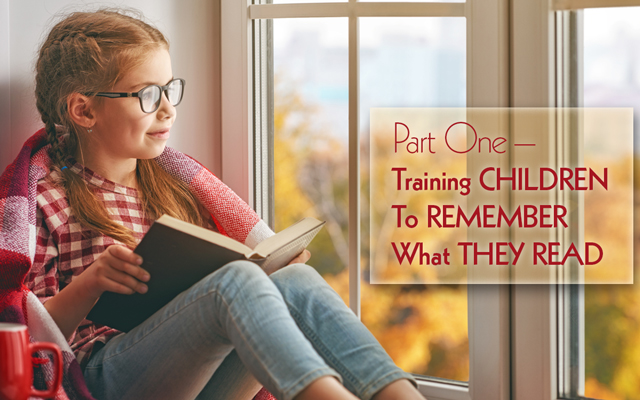Training Children to Remember What They Read – Part One


“You and I remember only what we know, and we know only what we remember.”1 This quote, hidden between the black cover ends of a 1943 book bearing the title How to Remember Names and Faces by Robert H. Nutt, has challenged my approach to reading. As an avid reader who relies on the written word for both my work and enjoyment, it also made me realize how much of what I have read has vanished from memory. Apparently, I’m not alone. Statistics reveal our knowledge retention through reading is only 10 percent. 10 percent! Out of a 300 page book, I’m only retaining thirty pages of this knowledge I invested money and time into. And if this be true for adults, how much more so for children? Thankfully, we can bump that percentage up, but not by relying on our brains alone. In the second part of this series we’ll get into the habits children can be trained to develop when reading, but first, let’s linger on changing our reading worldview.
Reforming Our Reading Worldview
As much as I love reading, the truth is I often see it as a checklist item, a book I need to digest as quickly as possible because there are many more for me to wolf down. You too? If so, it’s likely your kids do as well. For me, it took realizing my default method of reading is costing me 90 percent of the knowledge already in my palms to understand I couldn’t afford not to change. This meant becoming an intentional reader, discerning what content is going to give me the most mileage for my time invested. It meant doing my reading job well the first round, which, like anything else, takes more time.
In reforming your children’s reading worldview, I suggest making changes gradually. If you are not already reading aloud together, now is the perfect time to start—only instead of speeding through this book, incorporate some of the habits we’ll cover in part two. Choose a fun story with no ties whatsoever to school. Tell your kids you want them to compete with themselves to remember as much as they possibly can about this story, and you are going to teach them how. Keep it light; keep it fun. The higher their interest in the story, the better your success will be, but don’t get caught up in grading yourself either. This has nothing to do with your children’s intellect or your abilities as their teacher. Relax, smile, and prepare to laugh a lot.
Take the rest of today to think of a story—maybe an old classic like The Swiss Family Robinson, Little Women, or one of O. Henry’s works—that will hook your children’s imaginations. Tomorrow, come prepared to learn the habits that give feet to this new worldview of reading in our coming post.
Kenzi Knapp is a follower of Christ, homeschool graduate and student of history. A fourth generation Missourian she enjoys writing about daily life enrolled in Gods great course of faith and His story throughout the ages at her blog, Honey Rock Hills.
1. Robert H. Nutt, How to Remember Names And Faces (New York: Simon and Schuster, 1943), 74.





































